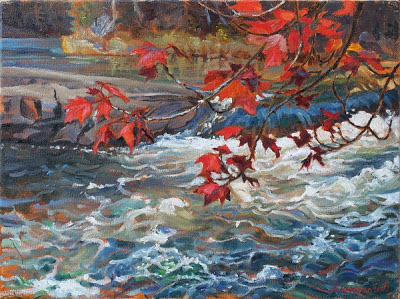Peggy's Cove Barrens (oil on canvas, 5 x 7 in.) Sold
1 September finds us on the road to the lighthouse at Peggy's Cove, undulating through a magical landscape of dish-shaped bogs, stunted spruces, and granite boulders, reminding me of taiga. Heaths of all colours and textures carpet the spaces between rocks, and the trees either hug the ground or flag sparse, weather tortured branches with tenacious knots of foliage. It's another hot day. Even at the coast, facing the open Atlantic our thermometer reads 29C. The horizon is a blur of haze and the sea is fairly calm, slight swells breaking in bright plumes on the rocky coast far below us. The coastline toward the lighthouse is dotted whitely with huge jumbled boulders like houses on a Spanish sea coast.
The lighthouse itself is seated firmly on massive glacier-shaped mounds of granite that slope roundly into the sea. When we first arrived we drove to the end of the road and found there a grey building near the lighthouse surrounded by parking lots filled with cars, and a waiting tour bus resplendent with stars and stripes.
The road is narrow with few pull-off spots, so to approach the barrens, which caught my interest more than the lighthouse or the sea, we parked at the Swiss-Air Disaster Memorial, and walked in on fenced paths to the large flat rock where the memorial stands, a round boulder cut in half and carved with an inscription, standing beside a similar shape, with three slots in its curved upper edge, through which I photograph the sea. People have left coins and small tokens in memory of those who lost their lives in the plane crash, and the brave fishing people who risked their lives to rescue them on the 2nd of September, 1998, twelve years ago tomorrow
Looking up slope from the memorial and the sea, I find my painting subject - rocks and trees in a dance with the sky.
The lighthouse itself is seated firmly on massive glacier-shaped mounds of granite that slope roundly into the sea. When we first arrived we drove to the end of the road and found there a grey building near the lighthouse surrounded by parking lots filled with cars, and a waiting tour bus resplendent with stars and stripes.
The road is narrow with few pull-off spots, so to approach the barrens, which caught my interest more than the lighthouse or the sea, we parked at the Swiss-Air Disaster Memorial, and walked in on fenced paths to the large flat rock where the memorial stands, a round boulder cut in half and carved with an inscription, standing beside a similar shape, with three slots in its curved upper edge, through which I photograph the sea. People have left coins and small tokens in memory of those who lost their lives in the plane crash, and the brave fishing people who risked their lives to rescue them on the 2nd of September, 1998, twelve years ago tomorrow
Looking up slope from the memorial and the sea, I find my painting subject - rocks and trees in a dance with the sky.




Back from the water, the barrens include low boggy areas, and along an ATV track through one of these I found a 100m stretch densely fuzzw with the flat stems and bottle-brush spore stalks of the little Clubmoss Lycopodium inundatum which I've fondly pursued through its scattered distribution since I was a boy. The track also supports Viburnum cassinoides, big Cranberries, Black Chokeberry, and Blackberrries in meagre fruit. While the landscape looks like something out of northern Manitoba, the flora is a mixture of northern and southern elements.
ReplyDeleteIt's a beautiful painting, and the scenery in that area -- I had no idea it existed until I drove from Halifax to Peggy's Cove this spring. I've seen trees stunted like that in the far north, but didn't expect them in Nova Scotia. Is it because of the salt air? No, because the BC coast has huge trees. The sparse soil? A fascinating landscape indeed.
ReplyDeleteKay
Alberta
The BC coastal trees can grow larger because the Pacific is a warmer ocean than the Atlantic. The North Pacific Gyre (used to be called the Japenese Current?) keeps the BC coast warm in winter. So the trees at Peggy's Cove experience wind and salt - and lots of snow and ice!
ReplyDelete